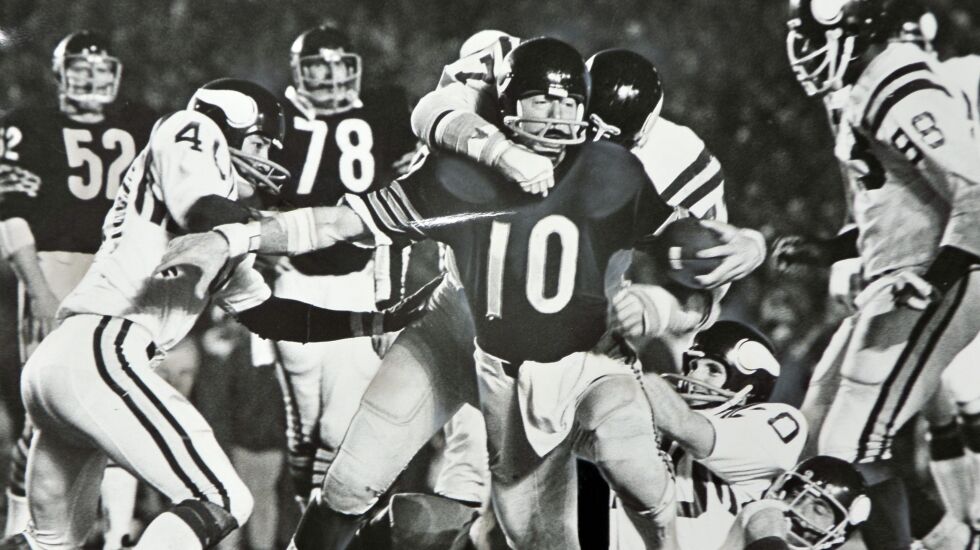
“You have to give him the green light,” Bobby Douglass says. “You let him run.”
The thing to remember here is that before Justin Fields, there was Bobby Douglass.
We’re talking about Bears quarterbacks who head upfield, not in terror but as a threat, using their fearlessness and athletic talent to strike fear into the opposing team.
Fields, the second-year Bears QB who has started only 19 pro games, ran for 178 yards Sunday against the Dolphins, the most rushing yards ever in a regular-season game by an NFL quarterback.
In 102 years.
The Bears lost 35-32, but it’s almost as if they won. Because what they found was a game-changing athlete in Fields, a certifiable outlier who could remake them in a new and exciting image.
For that to happen, the Bears’ management and coaching staff must understand what they have in this rare, glimmering gem. It seems they might.
That’s something the Bears never seemed to fully appreciate with Douglass when he played for them from 1969 to 1975.
Douglass was big, strong, fast and agile. The program listed him at 6-4, 225, but, as he points out with a chuckle, “I played at 240. The Bears’ PR staff was not on top of a lot of stuff back then.”
He wasn’t the most accurate passer, but his arm was strong and had to be feared as a deep threat from almost anywhere on the field. Indeed, it was said he could throw from one goal line to the other, but actually, he admits, 90 yards was his limit.
But when he ran, look out.
In 14 games in 1972, he rushed for 968 yards and eight touchdowns, with a long run of 57 yards, which, incidentally, is right up there with the 61-yard touchdown run Fields had against the Dolphins. That 968-yard rushing total was a record for quarterbacks that stood for decades until it was broken by the Falcons’ Michael Vick in 2006.
The Bears weren’t very good when Douglass played. The coaching was suspect, the talent was middling and it wasn’t clear what the offensive philosophy was. But the games, as long as Douglass was starting, were adventures in observational thrills (and mayhem). Douglass was a bruising match for linebackers. Poor defensive backs, should he make it into the secondary, were mere pests to be destroyed.
Indeed, Douglass, like only a few quarterbacks before him, actually sought out contact, clubbing would-be tacklers with his forearm or simply running them over. And that was after having used his instinctive athletic skills to cut and dodge as much traffic as possible.
Unfortunately, he was seen almost as a novelty act, a curiosity that occurred mostly because he couldn’t pass as accurately as peers such as Roger Staubach, Terry Bradshaw and Ken Anderson.
Like Archie Manning with the woeful Saints, Douglass was perceived as a quarterback who ran because he had to, not because he wanted to. To a large degree, this was wrong.
“Oh, I loved running,” Douglass says, still looking fit at 75, sitting in a Lake Forest coffee shop wearing a blue pullover and black shorts on a 50-degree day. “But back then, quarterbacks weren’t supposed to run. I would have loved to play for a coach who used my ability.”
That’s where he thinks the 6-3, 228-pound Fields comes in. With his new confidence, the young man can be a devastating threat, perhaps someday even rivaling running quarterbacks such as the Ravens’ Lamar Jackson and the Bills’ Josh Allen, using all the advantages the modern game gives a big, fast helmsman.
Douglass lists the changes that make the running quarterback a greater threat than ever: new blocking rules, no bump-and-run on receivers, the quarterback safety slide, multiple fleet receivers opening up the field like rabbits in a carrot patch.
Douglass guesses about 70% of his own runs were scrambles, and he wishes there had been a lot more designed rushing plays for him. But what about getting hurt? Quarterbacks need to stay healthy.
“It’s understood that if a guy runs, he’s gonna get hurt,” Douglass says with a shrug.
But you protect yourself. A lefty, he used his right side to collide with tacklers. His biggest injury was a damaged knee he got from Astroturf, not a defender.
“Everything’s about timing, rhythm, knowing your teammates, coaching the kid up,” he says. “There’s so much room on the field. Give Fields the green light.”







